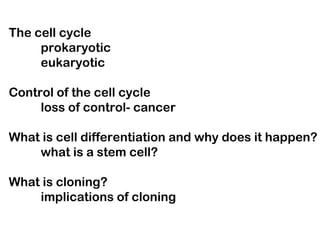
The Cell Cycle and Cancer Control: A Guide to Cell Growth, Division, and Death
- 1. The cell cycle prokaryotic eukaryotic Control of the cell cycle loss of control- cancer What is cell differentiation and why does it happen? what is a stem cell? What is cloning? implications of cloning
- 2. Cell division prokaryotes- binary fission one bacterium divides into two one circular chromosome replicates beforehand two identical daughter cells form can take as little as 15 minutes eukaryotes DNA is replicated before cell division somatic cells- mitosis two identical daughter cells germ cells- meiosis gametes (sperm and eggs) which fuse to form a zygote takes much longer
- 4. Eukaryotic cells have several chromosomes Number varies among species (p. 138) humans have 46 (23 pairs) diploid organisms have pairs of chromosomes chromosome structure is complex How much of that chromosome actually contains genetic information?
- 7. How long does the cell cycle last? Depends on the cell stem cells, embryonic cells- a few hours (embryonic cells don’t really have G1 and G2- why?) Some cells divide very slowly Some cells divide when induced liver lymphocytes
- 8. Cell division Cells grow during interphase DNA is replicated during S phase Division of nucleus during M phase (mitosis) Division of cytoplasm (cytokinesis) Programmed cell death (apoptosis) Cells divide only a certain number of times and then die (Hayflick limit) Role of telomeres?
- 9. Control of cell cycle- by special proteins and enzymes that act as switches G1 checkpoint- stop, pause or go into S phase some cells stop permanently G2 checkpoint- will cell divide? M checkpoint- formation of new cells
- 10. Early 1970s M phase drives G1 cell into mitosis, even though S phase has not occurred S + G1: G1 cell starts S phase S phase + G2: G2 will not undergo DNA synthesis
- 11. I. G1 varies the most among cell types first of several checkpoints is seen What determines whether a cell will grow? Single-celled organisms grow if enough nutrients are present Multicellular organisms must grow in a controlled way: growth factors Mitogens stimulate cells to go into S phase
- 12. Many growth factors have been described how do they work? Bind to tyrosine kinase receptors Activate Ras pathway (a small membrane G protein) ↓ Cascade of phosphorylation reactions, followed by transcription Cell passes into S phase
- 13. II. G2 checkpoint (between G2 and M) DNA synthesis must be complete and correct Cell may be arrested at this point This checkpoint tends to be more important in certain types of cells, e.g., fertilized frog eggs and certain strains of yeast
- 14. Cyclin-dependent kinases (Cdk) first discovered in yeast Different kinds of cyclins; levels oscillate at different stages of cycle Control mechanisms availability of cyclins varies Cdk must be phosphorylated Cyclin and Cdk must be bound together to be active
- 15. Initial cyclin-Cdk complex is inactive a series of phosphorylation and dephos- phorylation steps make it active Complex is called MPF (mitosis-promoting factor) Present in both mitosis and meiosis highly conserved
- 16. MPF activates a complex that degrades cyclin
- 17. G1 checkpoints Rb prevents cell moving into S phase by binding to a transcription factor When Rb is phoshporylated it cannot bind so cell can move into S phase p53 prevents damaged from dividing (by inhibiting Rb pathway) Abnormalities in both genes are associated with hereditary forms of cancer
- 18. III. Spindle assembly checkpoint, between metaphase and anaphase Cell cycle can be arrested if spindle fibers are not attached properly to chromatids
- 20. Cell growth is usually tightly regulated Controls: contact inhibition- cells will grow to a certain density finite number of cell divisions “gatekeeper genes” proto-oncogenes- stimulate growth some make growth factors some respond to growth factors
- 21. Types of proto-oncogenes Growth factors Receptors (G protein and tyrosine kinase) Kinases Transcription factors Cdk-kinases Mutant forms, oncogenes that promote cancer, have been identified in every category
- 22. Tumor suppressors- inhibit cell growth Cancers occur when cells grow out of control invade and damage tissues cells themselves may not function properly How does this happen? Mutations accumulate in DNA
- 23. If mutations occur in control genes, they can’t regulate cell growth Some defects in particular genes are associated with specific cancers BRCA-1 tumor suppressor gene associated with some inherited breast cancers p53- tumor suppressor- associated with many colon, bladder, breast, brain, lung cancers (about half of all cancers!)
- 25. What about this “cell destruction”? Damaged cell undergoes apoptosis (programmed cell death) Genetically regulated- cell has genes that both promote and inhibit death How does programmed cell death differ from death by injury?
- 27. Inheritance of “cancer gene”: Each cell has 2 copies of p53. If both become damaged, they lose control of cell growth If you inherit one “damaged” copy, you’re halfway there! Mutations occur over time- cancer is more common in older people Most cancer is NOT inherited; environmental damage causes most cancer
- 28. What sorts of things cause this damage? Radiation Toxins Chemicals Our bodies have many processes that repair damaged DNA
- 29. Avoid sun exposure Avoid smoking Eat moderately; consume fiber. Some foods may help prevent cancer? Early detection (especially important if you have a family history of cancer)
- 30. As more is known about mechanisms of uncontrolled cell growth, new treatment strategies will emerge Radiation Chemotherapy Immunotherapy Kinase inhibitors Angiogenesis inhibitors Gene replacement
